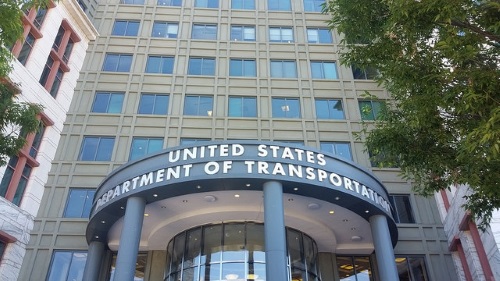The U.S. Department of Transportation is seeking public comment on the use and integration of vehicle-to-everything or V2X communications technologies to improve motor vehicle safety as well as support connected and automated vehicle or CAV needs.
[Above photo by Beyond DC.]
The agency noted in a Dec. 18 statement that the “V2X” designation groups together several different communication types: vehicle-to-vehicle or V2V; vehicle-to-infrastructure or V2I; and vehicle-to-pedestrian or V2P systems.
USDOT added that this particular that this request for comment “intends to maintain the priority use of 5.9Ghz spectrum for transportation safety communication,” which is a position reiterated in its latest CAV guidance, entitled “Preparing for the Future of Transportation: Automated Vehicles 3.0.”
“The automotive industry and municipalities are already deploying V2X technology and actively utilizing all seven channels of the 5.9 GHz band,” the agency said in its statement.

“There are more than 70 active deployments of V2X communications with thousands of vehicles already on the road,” USDOT added. “During this time, there have also been developments in core aspects of communications technologies that could further support V2X in addition to Dedicated Short-Range Communications [DSRC], including Cellular-V2X [C-V2X], [and] the development of potential ‘5G’ communications or other future transportation safety technologies.”
To that end, USDOT stressed that it is requesting feedback on both “current and future communications” technologies that could be associated with the CAV environment and how those developments affect both V2X deployment and the agency’s role in encouraging the integration of V2X into the transportation environment.

In particular, USDOT is seeking insight ranging from the use of alternative and emerging communications technologies in support V2X to the challenges associated with achieving “interoperability” while accommodating technological change.
Three policy letters issued by the American Association of State Highway and Transportation Officials in late November address some of those issues, including the need to preserve priority use of the 5.9Ghz spectrum for transportation and the need to support current investments in DSRC technology.
“AASHTO’s current position is that DSRC, which operates in the 5.9 GHz spectrum, is the only viable technology available to support [autonomous] vehicle applications at this time,” the group said. “Its use to enhance safety, and ultimately reduce crashes and fatalities, is critical. However, AASHTO does recognize that future technologies may become available … that are similar or better than DSRC and the industry must flexible to adopt these technologies as appropriate.”
 Top Stories
Top Stories
New AASHTO Leadership Elected at 2025 Annual Meeting
November 21, 2025 Top Stories
Top Stories

